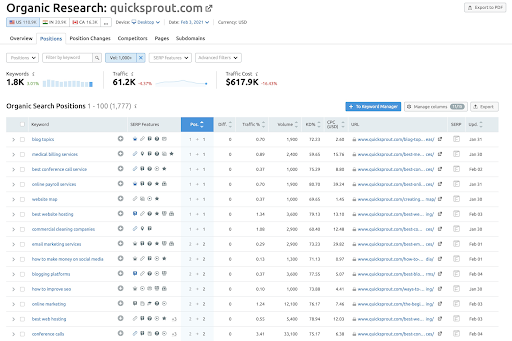
3 quick ways to run SEO competitor analysis for beginners
Competitor analysis refers to the processes that help you understand how your website stands in the search engines as compared to your competitors and other websites in your niche.
SEO is often considered a zero-sum game. There are only a limited number of spots (usually 10) on the first page of Google. Moreover, a disproportionate amount of traffic goes to the first 3 pages.
It means that your gain will likely mean a loss for someone else and vice versa.
That’s why competitor analysis — knowing where your competitors are ranking, what they are doing to rank higher, and how to overtake them in the SERPs — is so important in the world of SEO.
However, if this is your first time with competitor SEO analysis, it can be daunting and overwhelming. In that case, here are 3 quick (and simple) ways to start with competitor analysis.
1. Keyword research and analysis
Keyword research and implementation is arguably the most important part of SEO — especially when it comes to competitor analysis.
The idea is to identify:
- The keywords that are important to you (it would also be important for your competitors)
- The keywords that your competitors are successfully ranking for
- The pages that your competitors are using to rank for said keywords
A tool like Ahrefs or SEMRush can make this job significantly easier.
For example, if you are using SEMRush, you can simply paste your competitor’s URL and run an organic research report. SEMRush will pull a list of all the keywords that the website is ranking for.
Sort by positions and apply traffic volume filters for more targeted results.
Once you identify a few keywords that you want to go after, shortlist the top pages that your competitor is using.
Analyze those pages and see what they are doing best and think of ways how you can make your content better than them.
2. Backlink analysis
Keyword selection and optimization is only half of the entire puzzle. Sometimes, keyword optimization isn’t enough. You also need a strong backlink profile to rank high for certain keywords.
This is especially helpful when you are trying to figure out why you are not ranking on top for a certain page and keyword phrase — despite doing everything right.
You may have an excellent piece of content, but your competitor may still outrank you.
The easiest way to identify the root cause of the problem is to check that URL’s backlink profile. More specifically:
- How many backlinks does that competitor page have?
- How many backlinks does your page have?
- How many unique referring domains link to your competitor page?
- How many unique referring domains link to your web page?
If you find a significant discrepancy in the SERPs, you can come to the conclusion that your web page does not have a “content” or “keyword optimization” problem. Instead, it has a backlink problem.
Once you identify that, the next step would be to solve that problem by building backlinks to your site and specific web pages.
By using an SEO or backlink analysis tool (like SpyFu, Ahrefs, Moz, etc.), you can identify the exact sources or websites that link to your competitors.
You can even identify the websites that link to your competitors but do not link to you. You can also filter to only unique websites — if you want to just focus on increasing unique referring domains.
After you have a list of those websites, you can initiate a link-building and manual outreach campaign.
3. Technical SEO
The last part of the equation is often how technically sound your website is. This usually includes basic SEO issues, such as missing meta tags, 404 errors, canonical problems, crawl issues, website loading speed, etc.
The easiest way would be to use website and SEO analysis tools to check your website and your competitors’ websites to see how good everyone is doing.
This will help you identify where you stand.
Then, regardless of your competitors’ performance in this department, you should fix all technical issues you find on your website.
Most SEO tools, like Ahrefs and SEMRush, give detailed information on exactly how to fix an issue.
Conclusion
Although there is often a lot more to competitor analysis, this quick three-step guide will set you on the right path.
Once you go through each step, you will not only have plenty of ideas of what you should do, but you would also have found many new opportunities and fixed several issues that might be plaguing your website.









